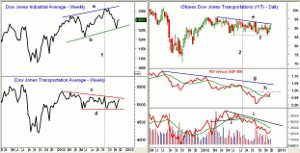For all the doom and gloom over the fiscal cliff plastered in the financial media, the market has continued to show signs of strength, except for one sector, which MoneyShow’s Tom Aspray examines.
It was another positive session for the stock market Thursday and not just because the major averages ended the day higher. What was more important was the market’s resiliency. As stocks gave up all of the early gains in reaction to Speaker Boehner’s comments, buyers soon stepped in.
Even the Dow Industrial Average has retraced 50% of its recent decline as the fiscal cliff selling in the dividend-heavy Dow stocks has been especially heavy. The Dow is up 4.4% from the mid-month lows while the Spyder Trust (SPY) has rallied 5.5%. Even more impressive are the 7.7% gain in the PowerShares QQQ Trust (QQQ) and the 8% gain in the iShares Russell 2000 Index (IWM).
The continued strength of the market rally now makes a test of the November lows less likely. Those who got caught up in the panic selling early in the month and dumped stocks may now be having regrets. I had cautioned investors at the time Don't Jump Off the Fiscal Cliff as I commented that “Reacting to the fear of an economic development like the fiscal cliff can never be part of a disciplined investment plan.”
Of course it is just as bad an idea to get caught up in the optimism and to buy indiscriminately especially with the major averages now at more important resistance. Many more stocks now have good looking charts but a patient, disciplined, and risk-adverse approach is still the best plan. There will be a pullback, likely in the next week or so, which should provide more attractive entry levels.
There is still one key market sector that has been lagging since early September and while it has been acting better recently, further strength is needed to power the market to new highs. Let’s take a look.
Chart Analysis: Comparing the charts of the Dow Jones Industrials and the Dow Jones Transportation Average has been a popular way to analyze the stock market for over 80 years. I like to use weekly close charts to spot divergences between the Industrials and Transports.
- The chart of the Dow Industrials shows a pattern of higher highs in 2012, line a.
- The highs in 2012 are also above those from 2011 when the Dow peaked at 12,886.
- In contrast the pattern of higher highs for the Dow Transports was broken in early 2012 as it peaked at 5,384, which was well below the 2011 high of 5,627.
- The divergence became more pronounced as the year progressed as the Transports formed slightly lower highs as indicated by line c.
- In early September, line 1, the three lower highs in the Transports, sent a strong warning.
- The Dow Jones Transportation Average has gained 3% more than the Industrials since the November 16 low.
- A weekly close below the support at 4,873, line d, would, of course, be more negative.
The iShares Dow Jones Transportation (IYT) had a low almost three weeks ago at $85.83, which was just below the early June low of $86.09, line f.
- The weekly chart (update through 11/29) has trend line resistance going back to March in the $92.28 area.
- A weekly close above $93.50 would be a strong signal that a new uptrend has begun.
- The weekly relative performance or RS line moved above its WMA in early November.
- The RS line needs to overcome the resistance at line h, to confirm it is outperforming the S&P 500. It is still well below the major downtrend, line g.
- The weekly on-balance volume (OBV) violated support, line j, in July (line 2) and has stayed negative.
- The OBV is well below both its declining WMA and the downtrend, line i.
What it Means: When both the Dow Jones Industrials and Transportation Averages are making new highs together, it strengthens the intermediate-term trend. The divergence since early in the year has made the market more vulnerable, and these two averages should be monitored regularly.
The Dow Industrials topped out in 2007 and failed to confirm the new highs by the Dow Transportation Average in May 2008, and we all know what happened next.
How to Profit: The first pullback in the Dow Jones Transports or IYT should allow us better to assess the recent rally’s strength.



















